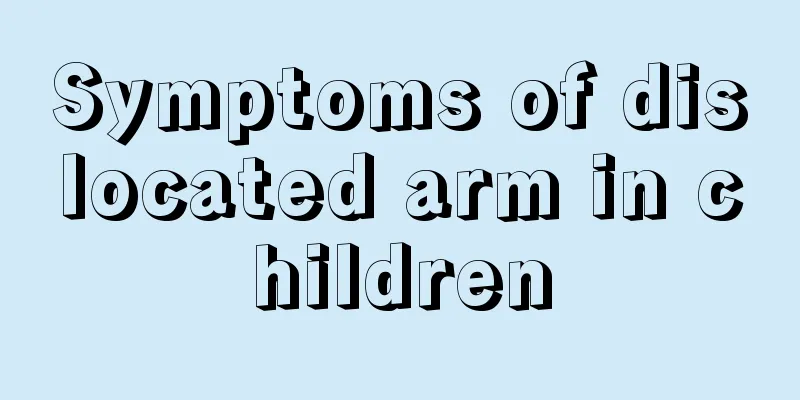Symptoms of dislocated arm in children

|
Children's bodies and bones are relatively fragile compared to adults, so if a child is accidentally hit or injured by something, it is very likely that the bones will be dislocated. Children will only feel pain when they have a dislocation, so many parents think that it is not a dislocation and ignore it. Everyone should know the symptoms of dislocation in children in advance. So that you can go to the hospital for treatment in time. Below, I will introduce to you the symptoms of arm dislocation in children. Move your baby's arms to see if he or she is crying, holding his or her arms at impossible angles, or showing any swelling. It is recommended that if you suspect dislocation, you should go to the hospital for examination and treatment. The main signs of dislocation in children are: The forearm is slightly flexed and internally rotated, and the affected limb cannot be raised due to pain, but there is no obvious abnormality in the appearance of the elbow joint, and some parts are slightly swollen. Measures to prevent dislocation in children include: When holding a child's arm, be gentle and don't use too much force. If a child falls suddenly, don't pull his arm with brute force. Treatment: Once a joint dislocation occurs, the patient's injured joint should be quietly fixed in the position that the patient feels most comfortable. Whenever possible, seek medical attention as soon as possible after proper fixation. Please note that when taking off the patient's clothes, the normal side should be taken off first, then the injured side, and vice versa when putting clothes on. (1) Shoulder dislocation generally requires reduction after anesthesia or muscle relaxation. Common reduction techniques include: ① His method: The patient lies in a supine position, the operator stands on the injured side, places the heel of the operator's side close to the affected limb in the axilla of the affected limb, and uses the fulcrum between the chest wall and the humeral head to hold the forearm and wrist of the affected limb and pull it along its longitudinal axis. After reaching a certain traction force, gently shake or internally and externally rotate the upper limbs and gradually move them closer to the trunk to reposition them. ② Use the traction and lifting method in a sitting position. The assistant holds the wrist of the affected limb and pulls it downward along the position of the affected limb. Use a fixation belt or another assistant to hold the upper chest and fix it. After traction, the surgeon uses the middle fingers of both hands or the index fingers to lift the displaced humeral head upward and outward under the axilla to reposition it. After reduction, X-ray examination is performed to check that the shoulder is completely reduced, and then the shoulder position is fixed with tape or bandage for 3 weeks. In case of habitual dislocation, repair surgery can be performed. (2) The patient is in the supine position after elbow dislocation. The assistant holds the upper arm of the affected limb for countertraction, while the surgeon holds the forearm and pulls it distally along the axis of the upper limb. After reduction, the upper limb plaster splint was fixed in the functional position for 3 weeks. (3) In case of radial head subluxation, the surgeon holds the elbow of the affected limb with one hand, with the thumb touching the radial head. With the other hand, the surgeon gently holds the wrist and applies gentle traction while pronating the forearm. When the elbow joint is flexed and the forearm is supinated, the surgeon will feel a crisp sound or bounce of the radial head, indicating that it has been repositioned. Bandage the forearm in a sling to protect the affected limb for 1 week. 4) Hip dislocation ① If the patient is in shock, lie flat, keep the airway open, keep warm and rush to the hospital for emergency treatment. ② Send to hospital urgently for manual reduction under anesthesia. ③After reduction, skin traction or hip spica plaster fixation can be used for 6 to 8 weeks. ④After removing the external fixation, you should continue to exercise your hip muscles and gradually increase the range of motion of the hip joint. (5) For open joint dislocation, debridement should be performed within 6 to 8 hours. After thorough debridement, the dislocation should be reduced, the joint capsule should be sutured, the soft tissue should be repaired, the skin should be sutured, and the drainage should be done with rubber strips for 48 hours. The joint should be fixed in the functional position with plaster for 3 to 4 weeks, and appropriate antibiotics should be used to prevent infection. |
<<: Symptoms of endocrine disorders in children
>>: Are mosquito repellent lamps harmful to babies?
Recommend
What to do if your baby has brain hypoxia?
Mothers all over the world know how hard it is to...
What to do if a newborn has congenital heart disease
Heart disease is the number one killer that threa...
What causes torticollis in children? Causes of torticollis in children
Torticollis in children, also known as goiter, is...
The child foams at the mouth and snores while sleeping
If a child foams at the mouth while sleeping and ...
How to bathe a newborn baby?
Bathing is a very easy thing for adults, but when...
Eruption order and timing of permanent teeth
When we grow to the age of four or five, the deci...
What should I do if my baby has coffee spots on his face?
The skin on the baby's face is relatively del...
Tips for children to prevent heatstroke in summer
When the weather is extremely hot in summer, even...
What are the reasons why children's faces turn pale?
In fact, every disease has a certain cause, but t...
What is facial dermatitis in children?
What parents worry about most for children is der...
What should I do if my child has dyshidrotic eczema?
The disease of dyshidrotic eczema has obvious sea...
Why is my baby's face so red and hot?
Taking care of a baby is a very difficult task. A...
Why do children sweat easily when sleeping?
Many children sweat excessively when they sleep. ...
What's wrong with a one-month-old baby who hasn't had a bowel movement for a day?
If a baby who is just one month old does not have...
What is the importance of nutritious breakfast for children?
The pace of life is getting faster and faster now...









